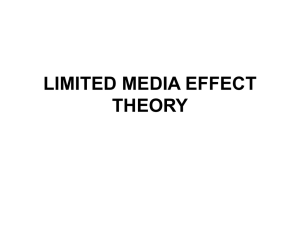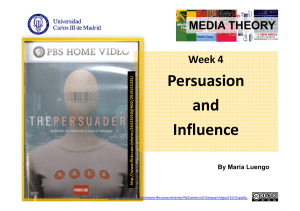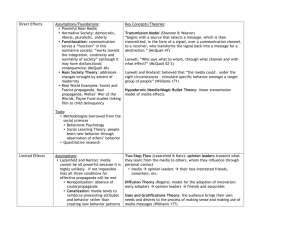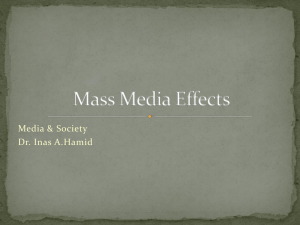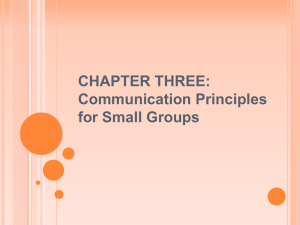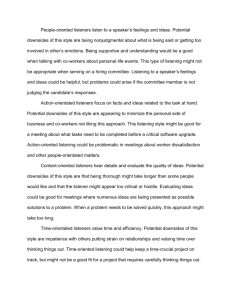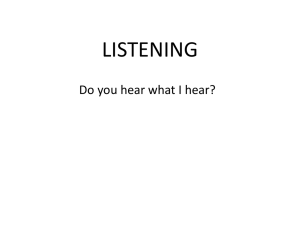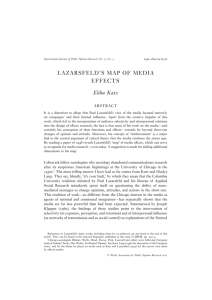Did Women Listen to News? A Critical
advertisement
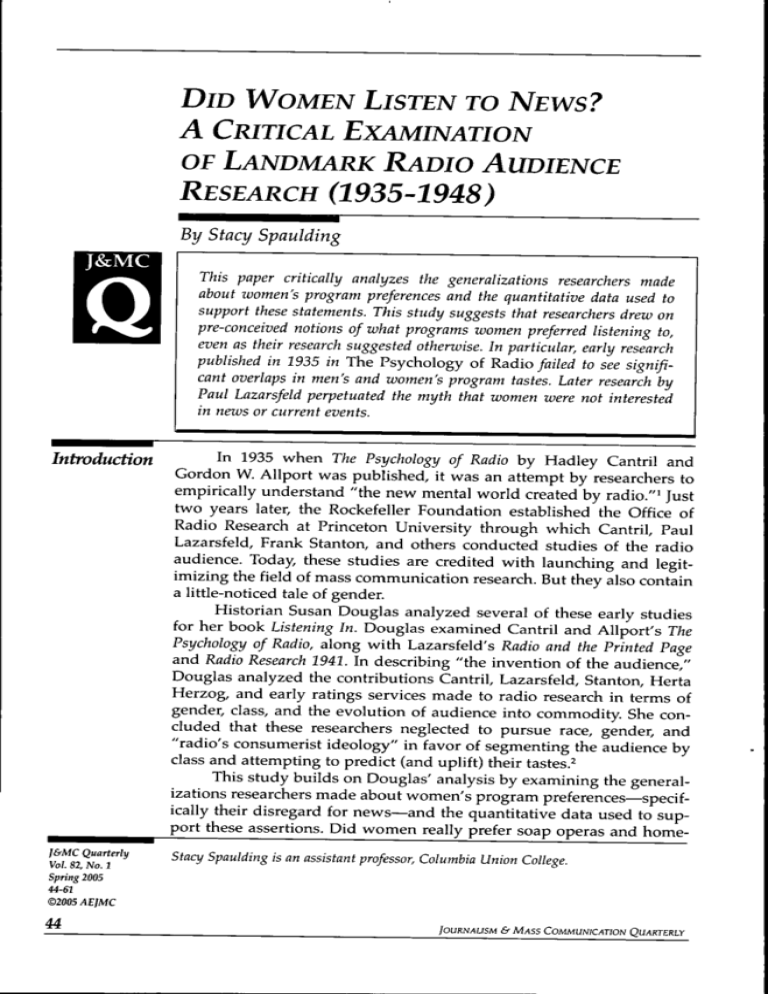
DID WOMEN LISTEN TO NEWS?
A CRITICAL EXAMINATION
OF LANDMARK RADIO AUDIENCE
RESEARCH (1935-1948)
By Stacy Spaulding
This paper critically analyzes the generalizations researchers made
about women's program preferences and the quantitative data used to
support these statements. This study suggests that researchers drew on
pre-conceived notions of what programs women preferred listening to,
even as their research suggested otherwise. In particular, early research
published in 1935 in The Psychology of Radio failed to see significant overlaps in men's and women's program tastes. Later research by
Paul Lazarsfeld perpetuated the myth that women were not interested
in news or current events.
Introduction
^ ^ ^
I&MC Quarterly
Vol. 82, No. 1
Spring 2005
44-61
©2005 AE]MC
44
I" 1935 when The Psychology of Radio by Hadley Cantril and
Gordon W. Allport was published, it was an attempt by researchers to
empirically understand "the new mental world created by radio."' Just
two years later, the Rockefeller Foundation established the Office of
Radio Research at Princeton University through which Cantril, Paul
Lazarsfeld, Frank Stanton, and others conducted studies of the radio
audience. Today, these studies are credited with launching and legitimizing the field of mass communication research. But they also contain
a little-noticed tale of gender.
Historian Susan Douglas analyzed several of these early studies
for her book Listening In. Douglas examined Cantril and AUport's The
Psychology of Radio, along with Lazarsfeld's Radio and the Printed Page
and Radio Research 1941. In describing "the invention of the audience,"
Douglas analyzed the contributions Cantril, Lazarsfeld, Stanton, Herta
Herzog, and early ratings services made to radio research in terms of
gender, class, and the evolution of audience into commodity. She concluded that these researchers neglected to pursue race, gender, and
"radio's consumerist ideology" in favor of segmenting the audience by
class and attempting to predict (and uplift) their tastes.^
This study builds on Douglas' analysis by examining the generalizations researchers made about women's program preferences—specifically their disregard for news—and the quantitative data used to support these assertions. Did women really prefer soap operas and homeStacy Spaulding is an assistant professor, Columbia Union College.
JOURNALISM & MASS COMMUNICATION QUARTERLY
making programs instead of news programs, as was commonly
believed? The evidence examined for this paper suggests that researchers failed to see the ways their own data contradicted the dominant ideology regarding women's program preferences. In particular, early
research published in 1935 in The Psychology of Radio did not report the
significant overlaps between men's and women's program tastes. Later
research by Lazarsfeld also perpetuated the myth that women were not
interested in news, though his data tables suggest otherwise.
This study is a narrative historical inquiry that values the concept
of gender as a lens through which to examine the past. It is important to
understand that this does not imply a "present-minded"^ analysis in
which the past is judged according to the cultural standards of today.
This study instead utilizes the concept of gender as a tool to uncover and
dissect the power and political relationships that shaped a particular
moment in history. Gender "seems to have been a persistent and recurrent way of enabling the signification of power," wrote historian Joan
Scott. "Gender, then, provides a way to decode meaning and to understand the complex connections among various forms of human interaction."'' Particularly when examining media history, gender allows the
researcher to uncover and examine cultural contradictions that are
often hidden within media narratives by a "façade of normalcy."^
Understanding this façade, and what it conceals, not only allows us to
understand how social power and interaction were enacted at one point
in media history, but how social power may have even shaped the narrative of media history itself.
This study first outlines the pertinent historical background by
describing early radio audience research, the gendered dichotomy of
radio programs, and the emergence and influence of Lazarsfeld and the
Bureau of Applied Social Research. An examination follows of the landmark studies in early radio research: The Psychology of Radio (1935) by
Cantril and Allport; Radio and the Printed Page (1940) by Lazarsfeld; Radio
Research 1941 by Lazarsfeld and Stanton; Radio Research 1942-43 by
Lazarsfeld and Stanton; The People Look at Radio (1946) by Lazarsfeld;
Radio Listening in America: The People Look at Radio—Again (1948) by
Lazarsfeld and Patricia L. Kendall. These studies—all but one products
of the Office of Radio Research and the Bureau of Applied Social
Research and shaped by Lazarsfeld—are important to examine. They are
credited with legitimizing mass communication research, establishing
the media effects tradition, and influencing mass media research and theory for years to come.
In 1926, when radio was still in its infancy, a letter to the
magazine Radio Broadcast sparked a debate that would last for
decades. Were women's voices suitable for radio? The answer is an
intriguing example of early audience research. The letter reported
the results of a poll of 5,000 WJZ listeners in New York that claimed
male voices were preferred nearly 100 to 1. Said WJZ manager Charles
B. Popenoe:
DID WOMEN LISTEN TO NEWS?
Historical
Background
45
It is difficult to say why the public should be so unanimous
about it. One reason may be that most receiving sets do not
reproduce perfectly the high notes. A man's voice "takes"
better. It has more volume. Then, announcers cover sporting
events, shows, concerts, operas and big public meetings.
Men are naturally better fltted for the average assignment of
the broadcast announcer.""
It is not known just how reliable the survey was. The original column in which the results were reported contains no clues as to how the
research was performed. Some historians doubt the legitimacy of the
poll. Michelle Hilmes, author of the book Radio Voices and a cultural history of broadcasting titled Only Connect, referred to the survey results as
"somewhat suspect" and said the results "would continue to be reported as fact and would act as a barrier to women in radio, except in daytime shows directed at female audiences."' Invisible Stars author Donna
Halper believes that the survey was not a reliable indicator of audience
preferences, since in the 1920s concepts of the audience and audience
research were not well deñned. Halper hypothesized that the survey
was not a scientific sample of listeners, but a collection of letters from
mostly male "active" listeners who were very vocal about what they
liked and disliked. These were the listeners most likely to write in to the
station, she wrote.*
As radio gained legitimacy, so did audience research. But the ability to cull a random or representative sample was not signiflcant to early
researchers focused on the commercial applications of the findings. "It
is assumed that the bias inherent in each method is not of great importance," wrote one researcher in 1934.' Some stations offered free items
to listeners who wrote to the station, a tactic that was likely to generate
an avalanche of letters but not a reliable sample of listeners. Telephone
interviews were also widely used, but this method was not able to capture the thousands of radio listeners who did not own telephones.
The problem of representing women's voices in audience research
wasn't the only gender issue debated by Radio Broadcast. A year earlier,
one columnist lamented the dichotomy of programs considered appropriate for women and men. Like the suitability of women's voices, this
issue would be debated for decades as programs were divided into
"male" and "female." Programs deemed to have a mostly male audience included commentary, news, and sports; women's programs
included homemaking, music, and soap operas.
Radio Broadcast columnist Kingsley Welles, in a 1925 column titled
"Do Women Know What They Want in Radio Programs?," praised a
Cambridge forum in which a graduate called for talks "of a non-domestic character" for female audience members. In a response to a call for
listeners to express their own views, 80% of the letters sided with the
graduate, Welles said. "Cookery, child welfare, and household management talks were not wanted. The general cry was: 'Take us out of the
kitchen and take us out of ourselves!' "'" As noted with the Popenoe
survey of WJZ listeners, a call for letters is by no means a reliable audi46
JOURNALISM & MASS
COMMUNICATION
QUARTERLY
ence sample. But what is notable is that in 1925 (just tive years after the
tirst radio broadcasts) some women were already speaking out against
so-called women's programs. Welles wrote:
Almost without exception American broadcast stations,
when they have a program for women, have limited it to the
obvious domestic things. No broadcaster has had the courage
or the intelligence to arrange a program to appeal to the intelligence of a woman. One wonders whether this failure is due
to a belief that it would be useless to make the attempt or
because the program designers simply fail to appreciate the
necessity."
As early as the 1920s, the female audience had been a powerful
draw for advertisers who realized that women made the majority of purchasing decisions. However, it is not known if early radio executives ever
seriously considered the power and influence of the female audience. In
the book Radio: The Fifth Estate, published in 1946 as a textbook for use
with NBC's Northwestern University Summer Radio Institute, radio pioneer Judith Carey Waller wrote that women's programs were frequently
"unwanted children—there to till the air until something better came
along."'^ They were always "a matter for perennial discussion and controversy" by male executives who considered women's preferences as
"more than slightly mysterious."'^
Radio executives did pay close attention to program ratings, however. But these ratings services—tirst the Crossleys and Hooperratings
and later the Nielsens—were commercially motivated, wrote Eileen R.
Meehan. They depended on measuring target audiences to create numbers they then sold to station managers and advertisers. The ratings
measured only the audience members that made a desirable target for
advertisers, what Meehan called the "consumerist caste." Others may
have enjoyed programs—men may have listened to soap operas, for
example, and women may have listened to sports—but these additional
audience members were "economically irrelevant" to the advertiser.''»
"Women's genres are designed to target the women in the consumerist
caste, and ratings are designed to measure only those ladies of the
house," Meehan wrote.'^ Thus, in its attempt to manufacture a saleable
audience, the economics of early radio may have legitimized the ideological divide of men's and women's programming, and even the domestic
division of labor itself."
Many early programming plans assumed women would be the primary audience. However, women were never recognized as such, wrote
Hilmes in Radio Voices." Radio at this time was flghting a batfle of definition. Was it a public institution or a commercial venture? Radio was
dependent on selling a product to an economic base of female audience
members. But broadcasters also had to convince regulators that they
existed to serve the public interest, not just sell a product. Thus, radio's
"mass/private/feminine base constantiy threatened to overwhelm its
'high'/public/masculine function."'"
DID WOMEN L;STEN TO NEWS?
This low culture/high culture division pervaded the early radio
audience research of one of the greatest figures in mass communicafion
research: Lazarsfeld. His Radio and the Printed Page, for example, sought
to discover how to "build audiences for serious broadcasts among people on lower culhiral levels.'"' This perspective had root in Lazarsfeld's
former life in Vienna, where he was a member of the Socialist
Democrafic Party of Austria, wrote Douglas. Lazarsfeld and his colleagues sought to improve condifions for the working class, hoping to
encourage them to spend less leisure fime carousing and more fime
reading, attending lectures, and listening to serious music. Lazarsfeld
fully took part in Vienna's unique mixture of culture and polifics, psychoanalysis, and Marxism, even playing the viola at regular chamber
music evenings.™
Though Vienna's socialist polifics were celebrated by intellectuals
and the working class alike, Douglas wrote that they embodied cultural
contradicfions that may have infiuenced Lazarsfeld's later research. The
pursuits advocated by Lazarsfeld and his peers in Vienna exemplified
these inherent inconsistencies in that they were "favored by the educated bourgeoisie, the very class Lazarsfeld and his comrades disdained."^'
These contradictions "crossed the Afianfic with Lazarsfeld and left their
mark on radio research and on concepfions of the radio audience,"
wrote Douglas.^^
Lazarsfeld came to the United States in 1933 as a visiting
Rockefeller Foundafion Fellow and decided to stay in 1935 to work
with the Radio Research Project at Princeton University. It was funded
by the Rockefeller Foundafion and directed by Cantril, Lazarsfeld, and
Stanton of CBS.^'' Lazarsfeld became director of the project, which
was renamed the Bureau of Applied Social Research in 1944 when
Rockefeller Foundation funding ended. Radio research confinued as
one branch within the Bureau, located at Columbia University.^'' Out
of both of these projects came a number of book-length studies on radio authored by Lazarsfeld and co-authored by a variety of other
researchers.
Lazarsfeld is revered for transforming sociological research methods and establishing mass communicafion research as a legitimate field
for academic research. "No one has had a greater influence in shaping
the current state of organized social research and training," wrote
Charles Y. Glock, a coder for Lazarsfeld from 1941 to 1942.^5 Lazarsfeld's
greatest contribufions, according to Glock, were his development of a
university-affiliated social science research organizafion, his pioneering
methodological advancements, his combined use of quanfitafive and
qualitafive methods, and his "clear formulafion of research problems."^^
Books on the history of mass communicafion research offer an
indicafion of the stature Lazarsfeld has been accorded in the field.
Wilbur Schramm called Lazarsfeld one of the "founding fathers" of
communication research.^' Everett M. Rogers credited Lazarsfeld with
"launching" mass communication study in media effects.^' Shearon A.
Lowery and Melvin L. DeFleur praised Lazarsfeld not only for inifiafing
the academic study of mass media, but also for legifimizing the study of
48
JOURNALISM & MASS COMMUNICATION QUARTERLY
"low culture" through research such as Herzog's qualitative study of
soap opera listeners.^'
These media histories also critique Lazarsfeld's contributions to the
field, such as his dependence on corporate grants to fund research.
Lazarsfeld had a background in market research and frequent contact
with successful businessmen who funded his research.^ He was wellknown for paying the debt from his last study with the grant from the
next and using corporate grants to fund his academic studies, a technique he termed "Robin Hooding."^' Lazarsfeld often did research for
CBS, NBC, and several advertising agencies, using the proceeds to pay
for his academic studies. '^ As a result of his dependence on funding, his
"correlations were a litfle too pat,"'' and he may have failed to explore
the data fully, Douglas wrote.
Lazarsfeld has been criticized for neglecting issues of ownership,
control, and state regulation of broadcasting as an industry.'^ In addition
to failing to critique the bureaucratic structures of the media, Lazarsfeld's
empirical work generated scores of statistics and data, but few real observations on human behavior.'^ Also troublesome is the elitist conception
of the audience in much of the work supervised by Lazarsfeld. Though
some scholars call Lazarsfeld's work "mildly elitist and sexist,"'*^
others are more direct in their censure. Douglas wrote that Lazarsfeld's
"ambivalence about the audience—uncultured, anti-intellectual knownothings who nonetheless deserved on-air cultural missionary work—
... legitimized a patronizing stance toward media audiences."^'
Missing from these ethical, empirical, and elitist concerns is a gender-based critique of this era of research. The absence of such a critique
was noticed in 1981 when scholar Helen Baer wrote that "a comprehensive feminist critique of the sexist orientation and assumptions of this
school of mainstream media sociology has yet to be written."'* The
beginnings of such a critique are evident in the work of contemporary
scholars. As noted earlier, Douglas wrote that early radio research
ignored women listeners in favor of "promoting a dominant, consumerist ideology."'^ And in her analysis of the political economy surrounding ratings services, Eileen R. Meehan has noted that the tendency
of early radio to promote consumerism was reinforced by the eagerness
of commercial ratings services to create audiences to sell to advertisers.""
But questions still remain about this era of mass communication
research that can be addressed by a gender-based critique. To what extent
did this research promote a particular view of women radio listeners for
commercial customers? What role did this research play in either promottng or questioning the dominant gender ideologies of the day? Just
as a feminist critique of media content analyzes how discourses of gender are encoded in media texts,"' a gender critique of this era of research
can draw on a similar focus. How are discourses of gender encoded in
media research? What meanings of gender are available in these texts?
How have these meanings influenced media content and society?
A gender critique can generate more knowledge about the way this
era of research institutionalized and privileged certain academic research
methods. Such a critique asks how social and cultural views of a particDiD WOMEN LISTEN TO
NEWS?
49
ular era creep into research, preserved by supposedly impartial statistics, and reinforce a particular view of history that may or may not be
correct. This allows researchers to critically examine not only the factual history of mass communication research, but even how the narrative
fabric of that history is constructed.
One of the first tasks in creating such a critique of mass communication research is to focus on the gender assumptions implicit in its
major works. This paper attempts to question one such gender assumption by asking whether women actually listened to news or not.
The
Psychologu
ofRadio
•'
Lazarsfeld called the Psychology of Radio "the tirst great book on
radio.""^ Published in 1935, Cantril and AUport's volume of experimen'^^ findings represented an important landmark in the beginning of
radio research. The authors regarded radio as a "signiticant social problem" for psychologists because of its feared potential for social control."^'
They hoped their data could ultimately help legislators determine how
best to control radio for social good.""
The picture of women listeners that emerges from this book is contradictory. The authors call attention to discrimination against women
announcers, but selectively analyze women's program preferences. To
assess program preferences, the authors surveyed 1,075 men and
women, asking them to rank 42 programs from most preferred to least
preferred (see Table 1). An initial analysis using Spearman's rho shows
there are correlations between men's and women's program preferences,
yielding a rho of .497 (p<0.01, two-tailed). Similar correlations also
occurred when examining program preferences for men and women
under 30 {r^= .548, p<0.01, two-tailed) and for men and women over 30
(r, = .515, p<0.01, two-tailed).
An analysis of the table for all men and women, when compared
with the accompanying narrative, is most revealing. The narrative
reports that all listeners, both men and women, enjoyed news reports,
various musical programs, drama, humor programs, and educational
talks."' But the authors also note that men and women have different
tastes. The researchers write that women enjoy symphonies, operas,
dance orchestras, short stories, literature, organ music, vocal artists, new
jazz songs, dance music, classical music, poetry, educational talks,
church music, sermons, and "of course, fashion reports and recipes."
Meanwhile, men are said to enjoy sports, business news, national policy
talks, detective stories, and talks on engineering, physics, or chemistry.
"Men even prefer advertisements to fashion reports," they write."*Though the study's narrative gives the impression that men's and
women's tastes are widely varied, a closer look at the data reported in
the table gives a different picture. In actuality, men's and women's tastes
may have overlapped a great deal, a reasonable finding in an era when
families typically owned only one radio and shared listening time. Five
types of programs rank among the top ten preferred programs for all
men and women: symphonies, old song favorites, dance orchestras,
news, and humorists. Men's and women's tastes are so similar, in fact,
that nearly half of all programs on the list are ranked within tive spots
^ "
JOURNALISM & MASS
COMMUNICATION
QUARTERLY
TABLE 1
Men's and Women's Rank Order of Radio Program Preferences
This is a compilation of men's and women's ranked order of radio programs, taken from The
Psychology of Radio, 1935. Table XII and XIII, pp. 91-92. The authors of the study used brackets to
indicate that a particular set of programs were tied for a ranked spot. A minus sign was used to
indicate a negative score, indicating listeners actually wanted to hear less of a particular program.
Rank
1
2
3
4
5
6
7
8
9
10
11
12
13
14
15
16
17
18
19
20
21
22
23
24
25
26
17
28
29
30
31
32
33
34
35
36
37
38
39
40
41
42
Total men
Football
Sports
Old song favorites 1
Boxing
J
News events
Baseball
Humorists
Dance Orchestras
Hockey
Symphonies
Drama
Educational talks
National policies "1
Psychology
r
Short stories
J
Health
T
Famous people J
Detective stories
History
Engineering
Vocal artists
"I
Physics or chemistry \
Tennis
J
Dance music
Operas
Literature
Educational methods
Organ music
Classical music
New jazz songs
Astronomy
Jazz singers
Church music
I
Phonograph records!
-Poetry
1
-Foreign language instruction J
-Political speeches
-Business and stock reports
-Sermons
-Recipes and cooking
-Advertisements
-Fashion reports
D I D WOMEN LISTEN TO
NEWS?
Total women
Symphonies
Old song favorites
Dance orchestras
Drama
Opéras
News events
Short stories
Humorists
Literature
Organ music
Educational talks
Psychology
Vocal artists
Health talks
New jazz songs
Famous people
Educational methods
History
National policies
Dance music
Classical music
Football
Fashion reports
Poetry
Sports
Detective stories
Church music
Recipes and cooking
Baseball
Jazz singers
Tennis
Boxing
\j
Astronomy
Sermons
Hockey
Foreign language instruction
-Phonograph records
-Physics or chemistry
-Poiitical speeches
-Engineering
-Business and stock reports
—Advertisements
51
of each other. The main difference between men's and women's preferences is not the prevalence of so-called women's programs, but men's
enthusiasm for sports. Half of men's top ten ranked programs were
sports-oriented, including football, boxing, baseball, and hockey.
In fact, of the programs the authors highlighted as "women's
favorites," only three were in women's top-ten ranked list. Most were
much lower on the list. Out of a total of 42 programs, dance music
ranked 20th, classical music ranked 21st, poetry ranked 24th, church
music ranked 27th, and sermons ranked 34th. Most surprisingly, some
programs thought to be highly favored by women ranked in die lower
half of the list: fashion reports ranked 23rd and recipes ranked 28th.
Perhaps most revealing in the narrative analysis is the authors' statement that women prefer listening to recipes and sermons. However, in
the table both programs are bracketed, indicating that they were tied
with other programs in the ranked list. In this case, recipes tied with
baseball and sermon programs tied with hockey. Though it sounds natural to say that women preferred sermons and recipes, the authors could
also have said women preferred listening to baseball and hockey.
Likewise, the authors claim that men prefer business news. This
type of program, however, is ranked 38th on men's list. Women ranked
it similarly at 41. Also, in both cases on the data table the program has a
minus sign in front of it, indicating the program had a cumulative negative score and that men and women actually wanted to hear less of this
type of program.
Germane to the topic of this paper, it must be noted that both men
and women report that they enjoy listening to news. The data show that
men ranked news as 5th and women ranked it 6th. Though the researchers
note that news ranked high with all listeners, they do not take special note
of women's high rankmg of news programs. This picture conti-adicts the
authors' expressed hopes of what radio could do for women. Early in the
book, they hope that "the housewife may tind the loud-speaker more
entertaining than the back fence as her mind becomes occupied with
affairs of the outside world rather than with those of her neighbors."*'
Other data in the book also reflect women's strong interest in news and
the effect radio had in increasing that interest. Of the women who
answered Cantril and Allport's research questionnaire, 72% reported
that they preferred listening to news events on the radio to reading about
them in the newspaper. And 91% reported that they preferred listening to
a speech on the radio rather than reading it in the newspaper.*^ Despite
their hopes that radio would cause housewives to be more concerned with
national and world affairs, the researchers did not make special note of a
clear statement from women that they enjoyed and even preferred radio
news to other programs and other media of news delivery.
Lazarsfeld
and Radio
Audience
Research
52
In 1940, flve years after the publication of The Psychology of Radio,
Lazarsfeld's flrst book-length work on radio was published. Radio and
the Printed Page represented a different approach to the study of radio.
While the research published in The Psychology of Radio was primarily
experimental. Radio and the Printed Page was a sociographic analysis of
JOURNALISM & MASS COMMUNICATION QUARTERLY
radio listeners. This shift was in part due to the influence of early rafings
services, according to oral histories of Lazarsfeld.
...I had never done experiments and it was only chemists
who do that, so what I wanted to do of course is go on
with the art of asking why ... And then I learned about
ratings, you see, the networks had always collected ratings,
and then I said, well, why don't we turn around ... find out
who listens to what in terms of age, sex and education, you
see?«
Lazarsfeld stated that he was an eligible candidate for the
Rockefeller Foundation's radio project because he had done radio
research for the Austrian government, but that he didn't see a difference
between radio research and other types of market research: "...there was
little difference between chocolate research and radio research."5° The
topic of radio never really interested him. Lazarsfeld found radio to be
"an undignified and trivial topic."'' He was never even sure if he was
ever genuinely interested in mass communication research:
You see, what became the earmark of early communicafions
research, which is this careful sociographic analysis of the
audience, you see, for which people still identify me, was an
unwilling compromise. I wanted to go on with the art of asking why, you see? But I knew enough how to handle that,
you see, and then I turned it into methodology and the whole
idea of survey analysis and the elaboration formula, and this
stuff. Then, I turned it around to something tolerable.^^
The radio studies supervised by Lazarsfeld confirmed that women
did make up a significant segment of the audience. Research published
in 1940 found that in rural areas, women spent more fime listening to
radio than men.^'^ This finding was also true in 1946 of women generally.^ In a 1941 survey of 93 women, three-quarters remembered at least
one instance in which they had been influenced by radio in their purchasing decisions. Of these women, more than half said they tried a new
product because they wanted to support a radio program.^'
Research published in Radio Listening in America showed that
women—always considered daytime listeners—did not turn off the
radio when prime-time programs and so-called men's programs came
on in the evening: "We can summarize our findings this way: A radio fan
in the morning is one in the afternoon and evening as well. Because of
their psychological characteristics, their fime schedules, and their lack of
competing interests, women who are heavy listeners at one period of the
day will tend to be radio fans throughout the day."'^
Gender, however, was not a consistent focus in any of this research.
The most consistent focus was on class and education. In Radio and the
Printed Page, Lazarsfeld stated that "programs which can be called 'lowbrow' are mainly favored by people on lower cultural levels,"^' and that
DID WOMEN LISTEN TO NEWS?
53
TABLE 2
Evening Program Preferences According to Sex and Amount
of Evening Listening
Taken from Radio Listening in America, 1948. Appendix C, Table 15, p. 137
Programs preferred by women
Less than 1 hour
Men
Women
Quiz and audience participation
Complete dramas
Semiclassical music
25
23
40%
28
27
56%
43
31
62%
53
37
65%
58
35
71%
64
42
70
43
46
40
22
55
32
23
10
19
81
68
52
52
31
74
62
42
16
24
87
73
57
59
32
78
72
44
30
25
yjjo
Men
2-3 hours
Women
3 or more hours
Women
Men
Programs preferred by men
News broadcasts
Comedy programs
Discussions of public issues
Sports programs
Hillbilly and western music
these programs "which are definitely preferred by people lower in the
cultural scale, are those which can be characterized as of deflnitely bad
taste."'^ The book advocated the concept of "audience building," or
intentionally creating conditions that facilitate an audience member's
acceptance of a "serious" broadcast.^' Admittedly, this concept has "ulterior social motives," wrote Lazarsfeld. It was tied to helping radio listeners read more books, listen to more "serious" music, and in general raise
the cultural level of the audience.™
Data that showed women did enjoy serious programming was
abundant in Lazarsfeld's Radio Listening in America: The People Look at
Radio—Again published in 1948. But this book, more than any other,
offers an inconsistent picture of female audience members. The study's
conclusions are contradicted by its own data tables. For example, in the
book's flrst chapter the authors note that the radio audience had no outstanding characteristics, except for one: "During the day most men are
at work, and the large majority of married women are at home. Women,
then, can more easily listen to the radio during the day, and they usually do. Because of this, one might modify the previous statements by saying that a sex difference is the outstanding characteristic of the radio
audience."^'
On flrst reading, this flnding seems to support the dichotomy of
men's and women's programs. Women listened during the day, when
women's programs were on. But, Lazarsfeld's comments indicate that
women listened to daytime radio out of convenience, not because of any
special distinctions of so-called women's programming. Lazarsfeld
wrote that the sex of the audience differs at certain times only because
of "time schedules of men and women," not because of "any inherent
appeals or characteristics of the medium."" He also wrote that
there was "no sex difference in demand for serious programs,"'^' and a
data summary even showed that in the daytime and evening hours
54
JOURNALISM & MASS
COMMUNICATION
QUAKTERLY
TABLE 3
The Constancy of Program Preferences
(1947 compared with 1945)
Taken from Radio Listening in America, 1948. Table 13, p. 21
Daytime Preferences: Daytime Preferences: Evening Preferences:
Men
Women
Both Sexes
1945
1947
1945
1947
1945
1947
News broadcasts
65%
n/a
Comedy programs
15
Popular and dance music
Talks or discussions about public issues 22
12
Classical music
19
Religious broadcasts
7
Serial dramas
13
Farm talks
5
Homemaking programs
14
Livestock/grain reports
61%
n/a
23
19
11
22
6
16
5
17
76%
n/a
35
21
23
35
37
12
44
6
71%
n/a
39
22
20
41
33
13
48
10
76%
54
42
40
32
20
n/a
n/a
n/a
n/a
74%
59
49
44
30
21
n/a
n/a
n/a
n/a
women overwhelmingly preferred news to other types of programs."
Nevertheless, he also claimed: "The average American woman, just like
American youth, is not interested in current affairs. This fact has been
discovered in so many areas of behavior that we are not surprised to find
it reflected also in program preferences. And it is indeed reflected, for
twice as many men like discussions of public issues and considerably
more men are interested in evening news broadcasts."^^
But this generalization does not represent the study's data (see
Table 2). The assertion that men listened to more news than women was
true only for audience members who spent less than one hour listening
to the radio in the evening. The more radio women listened to, the higher they ranked news and public discussions. And though news broadcasts are listed under "programs preferred by men," a careful reading of
the statistics in the table shows that news broadcasts were the most popular type of program for all groups of women. This finding is unchanged
from the original survey, published in 1946. Both men and women
reported that they listened to news more often than any other program
during both daytime and evening hours.'''*
These data do not show that men preferred news while women
were not interested in current affairs. The cause for this contradiction is
not apparent in the study. But a second table of data in the same study
confirms that women also preferred daytime news broadcasts over
broadcasts of soap operas and recipes. These data (see Table 3) show that
during the daytime, women listened to news and public issues programming at either the same or greater rates than men. The data show that a
greater percentage of women preferred news over homemaking programs and soap operas. This table also shows that these preferences
remained more or less constant between the 1947 and 1945 surveys that
were the basis for Lazarsfeld's Radio Listening in America and The People
Look at Radio.
DID WOMEN LISTEN TO NEWS?
55
It is also in\portant to note here that considerably more women
preferred news broadcasts to homemaking programs, and that these
numbers showed relatively little change between 1945 and 1947. This
preference is distinct: 71% of women surveyed reported preferences for
news broadcasts in 1947 compared to 48% who reported liking homemaking programs, a difference of 23%. This table shows that even fewer
women reported preferences for daytime soap operas or "serial dramas"—only 33%.
Discussion
56
Though early radio researchers generally believed that women
were not interested in current affairs, this examination of early radio
studies shows that women consistently ranked news programs among
their favorites. As early as 1935, The Psychology of Radio helped to perpetuate false assumptions regarding women's tastes by failing to recognize
that the majority of men's and women's favorite programs overlapped.
This study's analysis showed that the principal gender difference in program tastes was not women's interest in soaps, recipes, and fashion, but
men's interests in sports. This helped to perpetuate a dominant—and
apparently false—dichotomy between men's and women's program
preferences that did not reflect social conditions. After all, an overlap in
program tastes seems probable during an era when most families
owned only one radio.
Even when women listened to the radio alone in the home—during the daytime hours—research by Lazarsfeld showed that women preferred news over soap operas and homemaking shows. Yet the narrative
accompanying Lazarsfeld's research perpetuated the myth that women
were not interested in news or current affairs, again reinforcing a false
gender dichotomy.
The idea that women did prefer news is a reasonable conclusion
since these early studies were conducted during the World War II era
when news programming increased dramatically. During the war the
networks aired about twenty foreign broadcasts a day.^^ In 1940, 12.3%
of the networks' evening hours was devoted to commentators, talks,
and news, and by 1945, news and commentary filled 19.3% of the
evening schedules.*" It seems unlikely that women did not listen to
news in such an environment—indeed, it seems more probable that
women could not escape listening to news.
In their eagerness to develop research methods to apply to the
new medium of radio, and their desire to uplift audience tastes, early
mass communication researchers failed to prevent preconceived notions
of women's program preferences from contaminating their analysis.
What is striking is the inconsistency of the narrative data analysis with
the overall aims of the research. If the purpose of these studies was to
discover a way to elevate audience tastes, and if women were blamed
for not having "serious" tastes, why not study women's preferences in
some depth?
In truth, women were frequently studied, but only in their capacity as listeners to daily soap operas. The People Look at Radio claims that
JOURNALISM & MASS COMMUNICATION QUARTERLY
"listeners to daytime serials are the most thoroughly studied and best
known sector of the radio audience."" There may be two reasons for this.
First was the Rockefeller Foundation's eagerness to improve radio programs. The foundation created the Oftice of Radio Research, after all,
with the explicit intent of uplifting radio programming after John D.
Rockefeller Jr. one day wondered if something might be done to improve
the quality of radio programs.™ Daytime serial dramas were often perceived as tasteless and women were the target audience of these programs. Thus, early radio research funded by the foundation may have
focused on women radio listeners solely in their capacity as soap opera
listeners.
Second, and perhaps more important, data on daytime serial listeners was intensely interesting to advertisers who were willing to pay for
such research. A daytime serial could cost as much as $600,000 to $1 million a year in 1940, according to Variety, which represented 75% to 100%
of the advertising budget for most products." Thus, detailed marketing
information on the preferences of serial listeners, and whether advertisements were reaching them, would have been valuable. Commercial contracts with serial drama sponsors were important to Lazarsfeld's
research both during his time at the ORR and at the Bureau. He estimated that from 1946 to 1948 as much as 80% of the Bureau's budget
came from commercial contracts, which were especially important as
Rockefeller Foundation funding eroded.''^ The availability of data on
women as soap opera listeners, and the willingness of daytime programming sponsors advertisers to pay for it, may have caused researchers to
fail to pursue women's interest in other programs—programs that
researchers may have considered more "serious" but for which there was
no available funding to investigate. This is borne out by archival evidence which shows that Herzog, known for her landmark qualitative
study of women soap opera listeners, "On Borrowed Experience," published in Radio Research 1942-43, met with marketing managers regarding
her data.'^ She was also in charge of a study prepared specifically for
advertisers by the ORR titled, "Daytime Serials: Their Audience and
Their Effect on Buying."^"
Other factors may also help to explain the neglect of women's program preferences. The Bureau, through which most of the studies analyzed here were conducted, was encumbered by its affiliation with
Columbia University, in that it was created as a vehicle for training sociology students in empirical methods.^^ Lazarsfeld stated: "... you
shouldn't believe it's a radio research office or anything of the kind.
Fortunately, we had $35,000 a year from the Rockefeller Foundation to
study radio. But for one thing, the Rockefeller Foundation took it too
seriously. You see, they were aware that I used this money partly to develop a program..."""
It is also important to note that Lazarsfeld's interest was not in
radio or mass communication research, but in methodology. Radio, for
Lazarsfeld, was a vehicle for developing empirical methods. In oral history testimony, he stated, "methodology is whatever I am writing about,
you see.""
DID WOMEN LISTEN TO NEWS?
57
Thus, Lazarsfeld developed methods to answer questions posed
by those with money, whether it was the Rockefeller Foundation, NBG,
or Kolynos tooth powder. Such a climate breeds a focus on generating
data, but not necessarily pursuing the cultural contradictions inherent in
the results. And these contradictions—the idea that women were not
interested Ln news—promoted a false image of the female audience that
clearly conflicts with the researchers' own data. This image has helped
to perpetuate a dominant ideology regarding women as mass media
consumers that demands a second look by researchers. Such an analysis
holds the potential to help researchers understand the ways gender ideology has shaped social experience and social power. It may also help
researchers understand the forces that influenced the birth of media
research and which may still influence the field today.
NOTES
1. Hadley Cantril and Gordon W. Allport, The Psychology of Radio
(New York: Harper, 1935), vii.
2. Susan J. Douglas, Listening In: Radio and the American Imagination
(New York: Times Books Random House, 1999), 148.
3. James D. Startt and Wm. David Sloan, Historical Methods in Mass
Communication (Northport, AL: Vision Press, 2003), 53-54.
4. Joan Wallach Scott, Gender and the Politics of History (New York:
Golumbia University Press, 1988), 45-46.
5. Michèle Hilmes, Radio Voices: American Broadcasting, 1922-1952
(Minneapolis: University of Minnesota Press, 1997), 289.
6. John Wallace, "Men Vs. Women Announcers," Radio Broadcast,
November 1926, 44-45.
7. Michèle Hilmes, Only Connect: A Cultural History of Broadcasting in
the United States (Belmont: Wadsworth, 2002), 48.
8. Donna Halper, Invisible Stars: A Social History of Women in
American Broadcasting (Armonk, NY: M.E. Sharpe, 2001), 42.
9. Frederick H. Lumley, "Synopsis of Methods," in Measurement in
Radio (Columbus: The Ohio State University, 1934), 227-32. Reprinted in
Lawrence W. Lichty and Malachi C. Topping, American Broadcasting: A
Source Book on the History of Radio and Television (New York: Hastings
House, 1975), 479-83.
10. Kingsley Welles, "Do Women Know What They Want in Radio
Programs?" Radio Broadcast, November 1925.
11. Welles, "Do Women Know What They Want in Radio Programs?"
12. Judith Carey Waller, Radio: The Fifth Estate (Boston: Houghton
Mifflin, 1946), 142.
13. Waller, Radio: The Fifth Estate, 141.
14. Eileen R. Meehan, "Heads of Household and Ladies of the House:
Gender, Genre, and Broadcast Ratings, 1929-1990," in Ruthless Criticism:
New Perspectives in U.S. Communication History, ed. William S. Solomon
and Robert W. McChesney (Minneapolis: University of Minnesota Press,
1993), 210.
5a
JOURNALISM & MASS COMMUNICATION QUARTERLY
15. Meehan, "Heads of Household and Ladies of the House: Gender,
Genre, and Broadcast Ratings, 1929-1990," 210.
16. Meehan, "Heads of Household and Ladies of the House: Gender,
Genre, and Broadcast Ratings, 1929-1990," 209,13.
17. Hilmes, Radio Voices, 147.
18. Hilmes, Radio Voices, 153.
19. Paul F. Lazarsfeld, Radio and the Printed Page (New York: Duell,
Sloan and Pearce, 1940), xiv
20. Hans Zeisel, "The Vienna Years," in Qualitative and Quantitative
Social Research: Papers in Honor of Paul P. Lazarsfeld, ed. Robert K. Merton,
James S. Goleman, and Peter H. Rossi (New York: The Free Press, 1979),
10,12.
21. Douglas, Listening In, 127.
22. Douglas, Listening In, 128.
23. Everett M. Rogers, A History of Communication Study (New York:
The Free Press, 1994), 256.
24. Rogers, A History of Communication Study, 291.
25. Charles Y Glock, "Organizational Innovation for Social Science
Research and Training," in Qualitative and Quantitative Social Research:
Papers in Honor of Paul F. Lazarsfeld, ed. Robert K. Merton, James S.
Coleman, and Peter H. Rossi (New York: The Free Press, 1979), 33.
26. Glock, "Organizational Innovation for Social Science Research and
Training," 26-28, 33.
27. Wilbur Schramm, "Communication Research in the United
States," in The Science of Human Communication: New Directions and New
Findings in Communication Research, ed. Wilbur Schramm (New York:
Basic Books, 1963), 2.
28. Rogers, A History of Communication Study, 246.
29. Shearon A. Lowery and Melvin L. DeFleur, Milestones in Mass
Communication Research: Media Effects, 3d ed. (White Plains, N.: Longman,
1995), 94-96.
30. Everett M. Rogers, "On Early Mass Communication Study,"
Journal of Broadcasting & Electronic Media 36 (4,1992).
31. Rogers, A History of Communication Study, 294.
32. Douglas, Listening In, 139.
33. Douglas, Listening In, 143.
34. Rogers, "On Early Mass Communication Study"; Todd Gitlin,
"Media Sociology: The Dominant Paradigm," Theory and Society (6,1978):
206.
35. C. Wright Mills, quoted in Rogers, A History of Communication
Study, 311.
36. Peter Simonson and Gabriel Weimann, "Critical Research at
Columbia," in Canonic Texts in Media Research: Are There Any? Should
There Be? How About These? ed. Elihu Katz, John Durham Peters, Tamar
Liebes, and Avril Orloff (Cambridge: Polity Press, 2003), 24.
37. Douglas, Listening In, 148-49.
38. Helen Baehr, "The Impact of Feminism on Media Studies—Just
Another Commercial Break?" in Men's Studies Modified: The Impact of
Feminism on the Academic Disciplines, ed. Dale Spender (Oxford:
DID WOMEN L/STEW TO NEWS?
59
Pergamon Press, 1981), 144.
39. Douglas, Listening In, 148,
40. Meehan, "Heads of Household and Ladies of the House: Gender,
Genre, and Broadcast Ratings, 1929-1990,"
41. Liesbet van Zoonen, Feminist Media Studies (London: Sage, 1994),
42.
42. "Professor Paul F. Lazarsfeld Oral Memoir" (The New York
Public Library-American Jewish Committee Oral History Collection,
Dorot Jewish Division, The New York Public Library, Astor, Lenox and
Tilden Foundations, 1975), 65.
43. Cantril and Allport, The Psychology of Radio, vii.
44. Cantril and Allport, The Psychology of Radio, viii.
45. Cantril and Allport, The Psychology of Radio, 92, 93.
46. Cantril and Allport, The Psychology of Radio, 94.
47. Cantril and Allport, The Psychology of Radio, 24.
48. Cantril and Allport, The Psychology of Radio, 99.
49. "Professor Paul F. Lazarsfeld Oral Memoir," 66.
50. "Professor Paul F. Lazarsfeld Oral Memoir," 65.
51. "Professor Paul F. Lazarsfeld Oral Memoir," 68.
52. "Professor Paul F. Lazarsfeld Oral Memoir," 69, 70.
53. Lazarsfeld, Radio and the Printed Page, 225.
54. Bureau of Applied Social Research Columbia University, The
People Look at Radio (Chapel Hill: University of North Carolina Press,
1946), 97, 98.
55. Paul F. Lazarsfeld and Frank N. Stanton, Radio Research (New
York: Duell, Sloan and Pearce, 1941), 270-72.
56. Paul F. Lazarsfeld and Patricia L. Kendall, Radio Listening in
America (New York: Prentice-Hall, 1948), 16.
57. Lazarsfeld, Radio and the Printed Page, 21.
58. Lazarsfeld, Radio and the Printed Page, 23.
59. Lazarsfeld, Radio and the Printed Page, 118-28.
60. Lazarsfeld, Radio and the Printed Page, 128-32.
61. Lazarsfeld and Kendall, Radio Listening in America, 14.
62. Lazarsfeld and Kendall, Radio Listening in America, 14.
63. Lazarsfeld and Kendall, Radio Listening in America, 40-41.
64. Lazarsfeld and Kendall, Radio Listening in America, 21, table 13.
This table reproduced here as Table 3.
65. Lazarsfeld and Kendall, Radio Listening in America, 27.
66. Columbia University, The People Look at Radio, 103, 33, 35, 38-39.
67. Erik Barnouw, The Golden Web, vol. 2 (New York: Oxford
University Press, 1968), 140.
68. Radio Broadcasting Yearbook, 1940-1947.
69. Columbia University, The People Look at Radio, 50.
70. Rogers, A History of Communication Study, 267.
71. Hubbell Robinson, Jr. "How Daytime Radio Got That Way," in
Variety, 26 June 1940, 41.
72. "Professor Paul F. Lazarsfeld Oral Memoir," 84.
73. Robert F. Elder, letter from Robert F. Elder, marketing manager of
Lever Brothers, to Herta Herzog, 8 February 1940.
oO
JOURNALISM & MASS COMMUNICATION QUARTERLY
74. Herta Herzog, "Daytime Serials: Their Audience and Their Effect
on Buying," in Bureau of Applied Social Research project files. Box 3, Folder
"B-0130-1, 2, 3, 4, 5, 6, 7 BSH-commercial studies" (Columbia University
rare book and manuscript library).
75. "The Reminiscences of Paul Felix Lazarsfeld," August 1962,
Columbia University Oral History Research Office Collection, 88.
76. "The Reminiscences of Paul Felix Lazarsfeld," 92-93.
77. "The Reminiscences of Paul Felix Lazarsfeld," 148.
DID WOMEN LISTEN TO NEWS?
61
Copyright of Journalism & Mass Communication Quarterly is the property of Association for Education in
Journalism & Mass Communication and its content may not be copied or emailed to multiple sites or posted to a
listserv without the copyright holder's express written permission. However, users may print, download, or
email articles for individual use.
